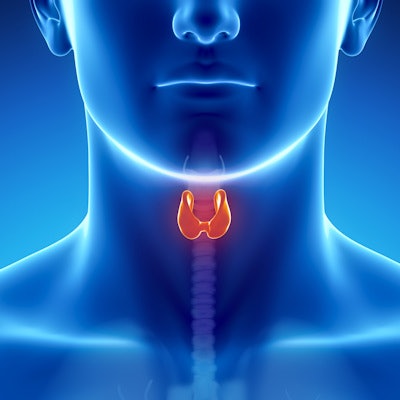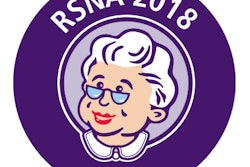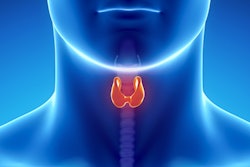
Citing the lack of evidence for an overall benefit as well as the risk of harm from overdiagnosis and overtreatment, the U.S. Preventive Services Task Force (USPSTF) has finalized its recommendation against the use of screening with neck palpation or ultrasound for thyroid cancer in low-risk, asymptomatic adults.
Updating its previous guidance from 1996, the USPSTF gave thyroid cancer screening a D grade, which indicates the task force believes there is moderate or high certainty that a medical service has no net benefit or that the harms outweighs its benefits. The D grade kept to the task force's draft recommendation published in November.
Writing in a statement published in the May 9 issue of the Journal of the American Medical Association, Vol. 317:18, pp. 1882-1887), the task force said it found inadequate evidence to estimate the accuracy of neck palpation or ultrasound as a screening test for thyroid cancer in asymptomatic people. It also pointed to a lack of adequate direct evidence that the screening tests improved health outcomes
"However, the USPSTF determined that the magnitude of benefit can be bounded as no greater than small, based on the relative rarity of thyroid cancer, the apparent lack of difference in outcomes between patients who are treated versus only monitored (i.e., for the most common tumor types), and the observational evidence demonstrating no change in mortality over time after introduction of a population-based screening program," the task force wrote.
Furthermore, the task force found inadequate direct evidence to assess the harm of screening for thyroid cancer in asymptomatic adults. However, the "USPSTF found adequate evidence to bound the magnitude of the overall harms of screening and treatment as at least moderate, based on adequate evidence of serious harms of treatment of thyroid cancer and evidence that overdiagnosis and overtreatment are likely consequences of screening," the group wrote.
As a result, the USPSTF said it concluded with moderate certainty that thyroid cancer screening in asymptomatic adults results in harms that outweigh the benefits.
Review process
The USPSTF's decision was based on an evidence report and systematic review prepared for the task force by a team led by Dr. Jennifer Lin of Kaiser Permanente Center for Health Research in Portland, OR. The group initially reviewed 707 full-text articles from searches of Medline, PubMed, and the Cochrane Central Register of Controlled Trials for relevant studies. The researchers then settled on 67 studies for the final analysis. Two reviewers independently appraised the papers and extracted study data from those they deemed to have fair-to-good quality (JAMA, May 9, 2017, Vol. 317:18, pp. 1888-1903).
Lin and colleagues found no studies that examined the benefit of thyroid cancer screening, although two studies showed that neck palpation was not sensitive for detecting thyroid nodules. The reviewers also noted that the combination of selected high-risk sonographic features was specific for thyroid malignancy in two methodologically limited studies.
As for harms, the reviewers found that three studies directly addressed the harms of thyroid cancer screening, but none suggested any serious harms from screening or ultrasound-guided fine-needle aspiration. However, no screening studies directly examined the risk for overdiagnosis, according to the group.
The researchers noted that two observational studies included patient cohorts treated for well-differentiated thyroid cancer as well as those with no surgery or surveillance. However, these studies didn't adjust for confounding factors and were therefore not designed to determine if patient outcome was improved by earlier or immediate treatment, according to the researchers.
Regarding treatment complications, the researchers found in 36 studies that the 95% confidence interval was 2.12 to 5.93 cases of permanent hypothyroidism per 100 thyroidectomies and 0.99 to 2.13 cases of recurrent laryngeal nerve palsy per 100 operations. Also, the reviewers said they found in 16 studies that treating differentiated thyroid cancer with radioactive iodine is associated with a small increase in the risk of second primary malignancies and with a higher risk of permanent adverse effects on the salivary gland, such as dry mouth.
"Although ultrasonography of the neck using high-risk sonographic characteristics plus follow-up cytology from fine-needle aspiration can identify thyroid cancers, it is unclear if population-based or targeted screening can decrease mortality rates or improve important patient health outcomes," the task force concluded. "Screening that results in the identification of indolent thyroid cancers, and treatment of these overdiagnosed cancers, may increase the risk of patient harms."
Opinions vary
In an editorial published online May 9 in JAMA: Otolaryngology -- Head and Neck Surgery, Dr. Louise Davies of the Veterans Affairs Medical Center in White River Junction, VT, and Dr. Luc Morris from Memorial Sloan Kettering Cancer Center in New York City said the USPSTF recommendation should discourage clinicians from screening for thyroid cancer with neck palpation, ultrasonography, or other techniques. They referred to the lack of evidence that detecting low-risk asymptomatic papillary thyroid cancer leads to a better outcome than just detecting and treating the cancer in symptomatic patients.
"In addition, given the prevalence of thyroid nodules and the typically slow growth trajectory of the most common form of thyroid cancer, screening programs will be associated with a clinically significant amount of harm," they wrote. "It is hoped that these recommendations will provide support in the United States for the development of monitoring programs for adults with small, incidentally identified cancers, with the ultimate goal of avoiding unnecessary treatments."
But perhaps overdiagnosis isn't to blame for the higher number of thyroid cancer diagnoses. In an editorial published online May 9 in JAMA Surgery, a team led by Dr. Julie Ann Sosa of Duke University Medical Center pointed to recent research that found an increase in overall thyroid cancer incidence over the past three decades, including higher incidence and mortality rates for advanced-stage papillary thyroid cancer.
What's more, overall incidence-based mortality also grew from 1994 to 2013 -- particularly for patients diagnosed with advanced-stage papillary thyroid cancer. These findings are consistent with a true increase in thyroid cancer occurrence in the U.S., and challenge the prevailing hypothesis that overdiagnosis is the sole culprit for this changing epidemiology, according to the group.
"These results suggest that a new focus should be placed on understanding alternative explanations for this increase other than overdiagnosis, including potentially modifiable factors, such as obesity and environmental exposures outside of the known influence of radiation," they wrote. "Furthermore, it would seem that additional energies and resources should be focused on supporting innovation and discovery around the management of locally advanced and metastatic thyroid cancer."
Nonetheless, the USPSTF recommendation may represent an opportunity to pause and recalibrate the collective approach to thyroid cancer screening, diagnosis, management, and surveillance, according to Sosa and colleagues.
"If the explanation for the rise in thyroid cancer is, indeed, not just overdiagnosis, and if mortality from thyroid cancer is also increasing, then enthusiasm for this (non)screening recommendation should be more muted," they wrote. "For clinicians and scientists working in the field of thyroidology, this is an interesting and compelling time. Clearly, more research is needed to identify alternative causes for the increasing incidence of the disease, to inform efforts at prevention, and to develop novel approaches to the management of advanced thyroid cancer."
Indeed, what the field needs is a noninvasive measure -- either radiographic or by biomarker -- to distinguish between nodules that have thyroid cells that will leave the capsule and cause morbidity and those that will not, said Dr. Anne Cappola of the University of Pennsylvania in an accompanying editorial in JAMA (May 9, 2017, Vol. 317:18, pp. 1840-1841).
"Using the same tools -- palpation, ultrasound imaging, and findings on microscopic examination -- is unlikely to result in a different conclusion about screening for thyroid cancer in the future," Cappola wrote. "New technologies are required."




















